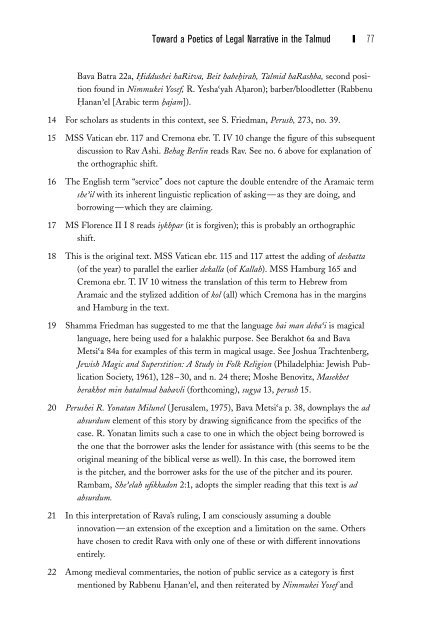Wimpfheimer_ Is it not so.pdf
Wimpfheimer_ Is it not so.pdf
Wimpfheimer_ Is it not so.pdf
You also want an ePaper? Increase the reach of your titles
YUMPU automatically turns print PDFs into web optimized ePapers that Google loves.
Toward a Poetics of Legal Narrative in the Talmud ❙ 77<br />
Bava Batra 22a, ¼iddushei haR<strong>it</strong>va, Be<strong>it</strong> habeirah, Talmid haRashba, second pos<strong>it</strong>ion<br />
found in Nimmukei Yosef, R. Yesha¦yah Aaron); barber/bloodletter (Rabbenu<br />
¼anan¥el [Arabic term ajam]).<br />
14 For scholars as students in this context, see S. Friedman, Perush, 273, no. 39.<br />
15 MSS Vatican ebr. 117 and Cremona ebr. T. IV 10 change the ®gure of this subsequent<br />
discussion to Rav Ashi. Behag Berlin reads Rav. See no. 6 above for explanation of<br />
the orthographic shift.<br />
16 The English term ``service'' does <strong>not</strong> capture the double entendre of the Aramaic term<br />
she¥il w<strong>it</strong>h <strong>it</strong>s inherent linguistic replication of askingÐas they are doing, and<br />
borrowingÐwhich they are claiming.<br />
17 MS Florence II I 8 reads iykhpar (<strong>it</strong> is forgiven); this is probably an orthographic<br />
shift.<br />
18 This is the original text. MSS Vatican ebr. 115 and 117 attest the adding of deshatta<br />
(of the year) to parallel the earlier dekalla (of Kallah). MSS Hamburg 165 and<br />
Cremona ebr. T. IV 10 w<strong>it</strong>ness the translation of this term to Hebrew from<br />
Aramaic and the stylized add<strong>it</strong>ion of kol (all) which Cremona has in the margins<br />
and Hamburg in the text.<br />
19 Shamma Friedman has suggested to me that the language hai man deba¦i is magical<br />
language, here being used for a halakhic purpose. See Berakhot 6a and Bava<br />
Metsi¦a 84a for examples of this term in magical usage. See Joshua Trachtenberg,<br />
Jewish Magic and Superst<strong>it</strong>ion: A Study in Folk Religion (Philadelphia: Jewish Publication<br />
Society, 1961), 128±30, and n. 24 there; Moshe Benov<strong>it</strong>z, Masekhet<br />
berakhot min hatalmud habavli (forthcoming), sugya 13, perush 15.<br />
20 Perushei R. Yonatan Milunel (Jerusalem, 1975), Bava Metsi¦a p. 38, downplays the ad<br />
absurdum element of this story by drawing signi®cance from the speci®cs of the<br />
case. R. Yonatan lim<strong>it</strong>s such a case to one in which the object being borrowed is<br />
the one that the borrower asks the lender for assistance w<strong>it</strong>h (this seems to be the<br />
original meaning of the biblical verse as well). In this case, the borrowed <strong>it</strong>em<br />
is the p<strong>it</strong>cher, and the borrower asks for the use of the p<strong>it</strong>cher and <strong>it</strong>s pourer.<br />
Rambam, She¥elah u®kkadon 2:1, adopts the simpler reading that this text is ad<br />
absurdum.<br />
21 In this interpretation of Rava's ruling, I am consciously assuming a double<br />
innovationÐan extension of the exception and a lim<strong>it</strong>ation on the same. Others<br />
have chosen to cred<strong>it</strong> Rava w<strong>it</strong>h only one of these or w<strong>it</strong>h di²erent innovations<br />
entirely.<br />
22 Among medieval commentaries, the <strong>not</strong>ion of public service as a category is ®rst<br />
mentioned by Rabbenu ¼anan¥el, and then re<strong>it</strong>erated by Nimmukei Yosef and

















